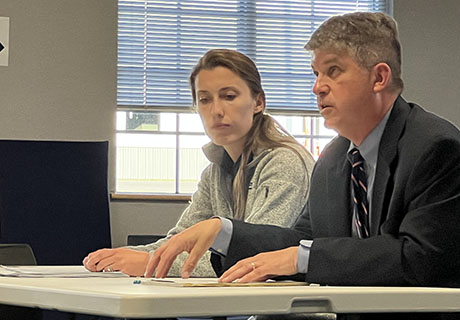Batavia planning board, solar farm developer try to strike balance on number of poles

Three poles at each entrance of a pair of proposed solar projects off of Ellicott Street Road in the Town of Batavia will be less of an eyesore than four, members of the town planning board decided on Tuesday.
At one time, the developer, Cypress Creek Renewables, proposed four poles.
At Tuesday's meeting, project attorney Mark T. Sweeney, after a lengthy discussion of the topic, asked the planning board to commit to three poles if that is truly their desire.
"What we would ask then is that the board clarify the condition of approval to require us to have a maximum of three poles per project," Sweeney said. "Then we can agree, we can accept that and redo a redesign for that. What we really need tonight is to be able to walk away knowing what it is we have to do. So that would be my ask of you as a board is to clarify and modify that condition of approval so that we can do that."
The number of poles is not a straightforward design decision, Sweeney explained during Tuesday's discussion. The equipment that is mounted on the poles can be placed on the ground but at much greater expense. The design must be approved by National Grid. The ground-mounted equipment is big and bulky and must be fenced in. And ground-mounted equipment is a special order and supply issues are delaying delivery.
Introduced in June 2019, the proposal from Cypress Creek Renewables LLC calls for the construction of two solar farms on property owned by Don Partridge at 5117 Ellicott Street Road.
- A 5-megawatt array on 18.2 acres of a 65-acre parcel of otherwise agricultural land, known as Trousdale Solar I;
- A 4-megawatt system on 19.6 acres of a 71-acre parcel of otherwise agricultural land, known as Trousdale Solar II.
The four-pole plan Cypress Creek came up with for each project -- and that received a nod of approval from National Grid -- helped the company balance competing factors and the company sought to maintain that balance, Sweeney said.
"There's a balance, you know, in what SEQR requires," Sweeney said. "The site plan evaluation requires a balance of the impacts versus the cost. One of the things we were looking at is just that element of it. I understand if there's a particular impact that is to be avoided, or identified that we weren't aware of, that's one thing, but just simply ground-mounting something at a significant cost would be -- for no significant benefit to the environment, from a visual standpoint -- would be in our position, something we've tried to avoid. "
When the equipment is ground-mounted, it must be placed on a two-foot-high base, Sweeney said. The equipment enclosure is six feet tall. And because it is electrical equipment, it must be surrounded by a fence.
"You do have some residual visual impact resulting from that installation," Sweeney said.
Board members asked why there couldn't be three poles at each location since other solar projects have been able to meet that requirement.
Sweeney said he couldn't answer that question.
"I understand completely where you're coming from, and having consistency with other projects," Sweeney said. "I don't know why those projects have three. I don't know what their equipment lineup is. I assume that it's substantially similar, but it might be different. The project size might be different panel types, inverter types -- there's a whole level of engineering that goes into what may cause the number to be different. It could be that it could have been an earlier project that got a higher incentive from NYSERDA by being in a different block. So they had more money available to spend on that type of thing. There may not have been any landscaping associated with that project. They could take the money from the landscaping budget and put it into that. There are all kinds of different things of which we're not aware."
To help mitigate the visual disturbance of four poles, the poles were designed to be back from the roadway and screened from view by landscaping.
In the end, board members decided they would rather see only three poles on each site.
"I think even four poles with all the lines and all the stuff hanging out from them, it's just going to be an eyesore, not only for people who live there, but just driving by," said board member Jonathan Long. "It just doesn't fit in with the character of the neighborhood. In my opinion, saying that it's a cost to the project is, in my opinion -- this is going to be there 20-plus years, part of the scenery there; it's not going to go away. So the upfront costs are minor compared to long-term impacts."
Once Sweeney said he would like board action affirming they would accept three poles instead of four, a motion was made and passed.
Photo: Bridget Cuddihy, project developer for Cypress Creek, and Mark Sweeney, project attorney. Photo by Howard Owens.
Previously:
